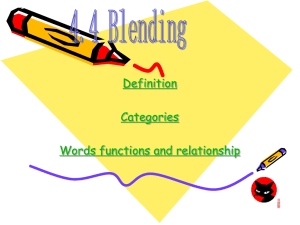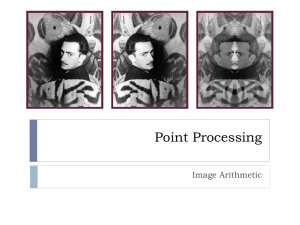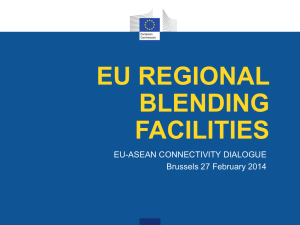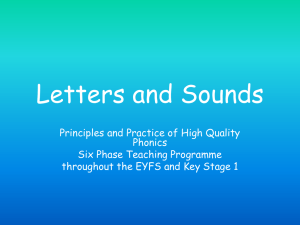University of California Hazardous Waste Action Group
advertisement
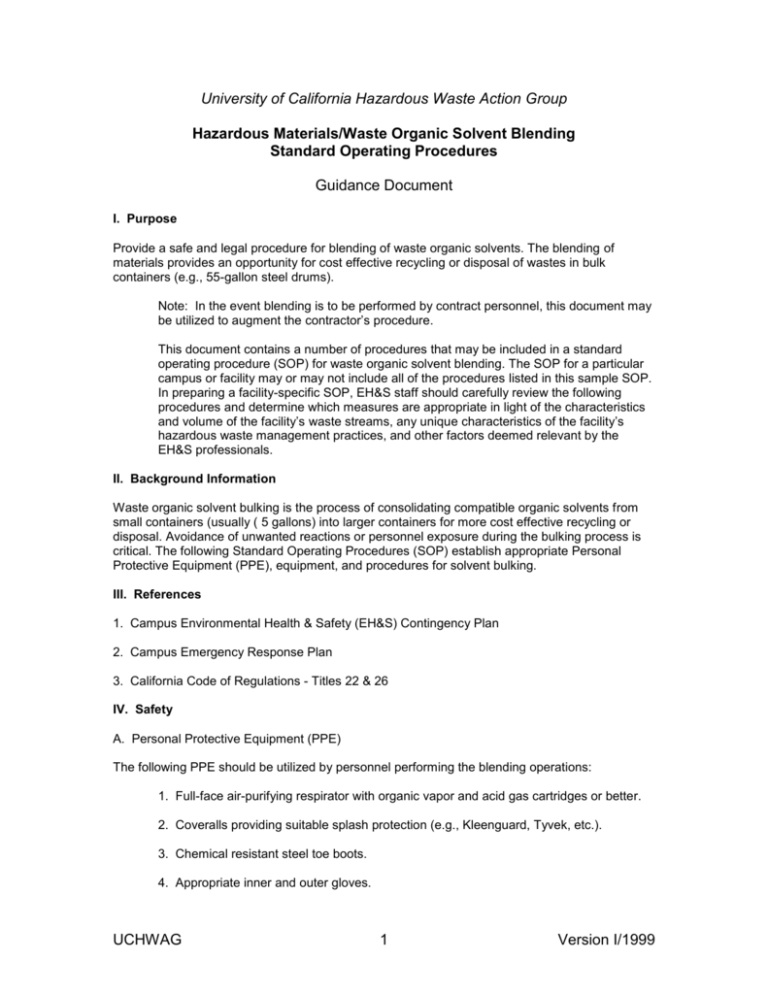
University of California Hazardous Waste Action Group Hazardous Materials/Waste Organic Solvent Blending Standard Operating Procedures Guidance Document I. Purpose Provide a safe and legal procedure for blending of waste organic solvents. The blending of materials provides an opportunity for cost effective recycling or disposal of wastes in bulk containers (e.g., 55-gallon steel drums). Note: In the event blending is to be performed by contract personnel, this document may be utilized to augment the contractor’s procedure. This document contains a number of procedures that may be included in a standard operating procedure (SOP) for waste organic solvent blending. The SOP for a particular campus or facility may or may not include all of the procedures listed in this sample SOP. In preparing a facility-specific SOP, EH&S staff should carefully review the following procedures and determine which measures are appropriate in light of the characteristics and volume of the facility’s waste streams, any unique characteristics of the facility’s hazardous waste management practices, and other factors deemed relevant by the EH&S professionals. II. Background Information Waste organic solvent bulking is the process of consolidating compatible organic solvents from small containers (usually ( 5 gallons) into larger containers for more cost effective recycling or disposal. Avoidance of unwanted reactions or personnel exposure during the bulking process is critical. The following Standard Operating Procedures (SOP) establish appropriate Personal Protective Equipment (PPE), equipment, and procedures for solvent bulking. III. References 1. Campus Environmental Health & Safety (EH&S) Contingency Plan 2. Campus Emergency Response Plan 3. California Code of Regulations - Titles 22 & 26 IV. Safety A. Personal Protective Equipment (PPE) The following PPE should be utilized by personnel performing the blending operations: 1. Full-face air-purifying respirator with organic vapor and acid gas cartridges or better. 2. Coveralls providing suitable splash protection (e.g., Kleenguard, Tyvek, etc.). 3. Chemical resistant steel toe boots. 4. Appropriate inner and outer gloves. UCHWAG 1 Version I/1999 B. Engineering Controls The following engineering controls shall be in place and operational prior to blending: 1. Verify there is adequate ventilation in the blending area. Use an approved method to ensure that the available ventilation/exhaust system(s) is operational (e.g., air flow indicator, velometer, etc.). 2. Indoor units should be built to fire code and be of intrinsically safe design. Ensure no ignition source is within 25 feet of blending operations. 3. Verify that an emergency shower/eyewash is located within 10 seconds or 100 feet and is functional and clear of obstructions or debris. 4. Visually inspect the spill containment system, this system should be capable of holding at minimum the entire contents of the largest expected container. 5. Ensure area fire suppression equipment and alarms are operational. Fire extinguishers should be located within 15 feet, with seals intact and gauges showing units are operational. 6. Non-blending personnel activities may be restricted during blending operations in order to restrict non-mandatory personnel access and ensure the safety of the blending personnel and operations. 7. Operators may elect to perform blending operations during select times of day to take advantage of weather conditions (e.g., during summer months campuses in Southern California may elect to bulk early in the day). V. Equipment The following equipment is to be available for blending operations: 1. Non-sparking bung wrench. 2. Spill control kit. 3. Fire extinguisher (see Section IV). 4. Approved grounding cables for drums to ground. 5. Spark arresting funnel(s) (grounded by direct contact to drum) equipped w/ screen and/or splash shield. 6. Approved bonding cables for container-to-drum bonding. 7. Organic vapor monitor (if deemed necessary by campus Industrial Hygienist). 8. Liquid level indicator. [Optional] 9. Liquid temperature monitor. 10. Gas evolution monitors (e.g., hydrogen gas monitor). [Optional] 11. Gas evolution detector (e.g., bubbler). [Optional] UCHWAG 2 Version I/1999 VI. Site Preparation 1. A minimum of two qualified and trained EH&S workers should perform bulking operations. 2. Check all engineering and safety controls (see Section IV). 3. Locate necessary fire extinguishers within 15 feet of blending operations. 4. Locate spill control equipment within 15 feet of blending operations. 5. Visually inspect drums to be used for cracks, corrosion, seam integrity, etc. Only Department of Transportation (DOT) approved drums should be used. Locate drum in blending area such that ventilation is adequate and airflow direction is away from personnel breathing zone. 6. Label drum/container with ID #, RCRA, DOT Hazard. Note: Labeling can be differed to the end of processing if adequate logs are kept. 7. Ground drums to designated locations. 8. Install selected drum-monitoring devices (e.g., temperature monitor, liquid level monitor, etc.). Verify monitors and monitor alarms are operational. 9. Install spark-arresting funnel in drum. 10. Make the appropriate grounding connections. 11. Verify proper operation of selected monitoring equipment. VII. Material Preparation Material preparation may vary depending upon vendor or TSDF requirements. Waste identification and compatibility testing prior to blending are specified below. A. Material Selection 1. Select materials from same type and hazard class according to ultimate disposal requirements. 2. Avoid high-risk waste streams (e.g., unknowns, items from laboratories with high hazard waste streams or difficulties accurately classifying wastes, etc.). 3. Omit any wastes containing items specifically prohibited. 4. Omit waste containers with unwanted or unusual solid layers (e.g., organic peroxide crystals). 5. New or non-routine waste streams should be tested as follows. Materials failing a test should be excluded from bulking. a. Oxidizers test using standard test strips or strips appropriate for solvent (test should be negative) UCHWAG 3 Version I/1999 b. Peroxide test should be ( 5 ppm. c. pH solvents intended for bulking should be at or near neutral but in no case ( 3 or ( 11 for non corrosive materials blending. B. Determination of Compatibility 1. Waste stream identification a. Review waste stream history to determine if i. Stream has been submitted before. ii. Generator waste stream identification was confirmed and determined to be accurate. iii. Stream was compatible with other materials in intended bulk stream, and safe stream blending has occurred in the past. 2. Compatibility testing (to be used with materials not meeting “a” above). a. Collect an aliquot from each container you plan to combine (e.g., 5 ml for each gallon of liquid to be blended. Make sure sample size is proportional to the items final percentage in the blended drum). At a minimum, sample size should be 10 ml/gallon. b. Sample multiple layers separately. c. Arrange your sample receptacle such that it can be monitored. At a minimum, monitoring will include a thermometer (placed such that temperature changes may be observed). Use a digital thermometer if available. A gas bubbler and a H2(g) monitor may also be used. d. One by one, combine samples into the flask. Leave time between samples similar to that used in actual bulking to observe the mixture for the following: 1. 2. 3. 4. 5. Temperature change ( 1 degrees Celsius Gas evolution Solids formation Viscosity increase Emulsion formation e. If any of the above changes are observed - consider the mixture incompatible. f. The test may be repeated, this time omitting the suspected incompatible sample. VIII. Operations A. Blending Operations 1. Isolate the area and remove all non-essential personnel. 2. A record of the composition and approximate volume of each material placed in the drum should be maintained (see your campus hazardous waste tracking procedures). UCHWAG 4 Version I/1999 3. Collect all tested containers intended for blending in each drum. Perform the following confirmations: a. Total estimated volumes to ensure the total intended item volume will not exceed the drum capacity; include room for 10% headspace in calculations. b. Verify no incompatible materials are included. c. Verify no unintended solid materials are present 4. Proceed with blending. Observe the drum temperature periodically during and between each container pouring using a temperature monitor. If a rapid temperature rise of more than 1 degree Celsius or obvious generation of gas are noted: a. Halt the blending operations immediately. b. Vacate the area. c. Implement the contingency plan to the appropriate level. 5. During and after the blending process, periodically check the temperature using the digital (if available) thermometer. Observation of any significant temperature change should be treated as those in section VIII 4. 6. After completion of pouring, visually re-inspect the exterior of the blending drum. 7. Blending should be accompanied by periodic mixing of the drum, preferably after each addition. 8. Upon completion of pouring, allow legal ventilation of the blending drum. Temporarily seal the drum with a pressure relief bung cap meeting set at the lowest operable relief point. The pressure relief bung cap should remain in place for a minimum of 24 hours after which time the drum will be observed for accumulated pressure prior to cap removal. Ideally, vent caps should remain in place until just prior to shipment. 9. Seal the drum prior to removing the bonding cable. B. Site Demobilization 1. Ensure all original containers (from which waste was poured) are RCRA empty. If sufficient materials remain in containers to warrant doing so, drain remaining liquids into an appropriate blending drum or other waste container. 2. Dispose of empty containers according to regulation and policy. 3. Check secondary containment for spilled liquids. Pump any liquid into appropriate waste container or absorb, label, and dispose with solid hazardous waste. 4. Verify blended drum(s) is closed, equipped with vent cap, and properly labeled. 5. Label drums as follows: a. Completed EPA generator label. b. Appropriate DOT hazard labels (e.g., hazard warning labels, “This End Up”, etc.). UCHWAG 5 Version I/1999 c. Completed packing list (if required). d. Drum number. e. Stream numbers/profiles as appropriate for intended ultimate disposal/recycling site. 6. Decontaminate and store all non-disposable equipment. 7. Collect, package, and label all disposable equipment for appropriate, legal disposal. 8. Remove PPE, clean, and store reusable PPE. Collect, package, and label disposable PPE for appropriate, legal disposal. C. Documentation and Record Keeping 1. Documentation signed by the individual determining that the materials were suitable for blending. 2. The logs of the materials actually blended. 3. Records of those materials rejected due to physical examination or testing failure. UCHWAG 6 Version I/1999
